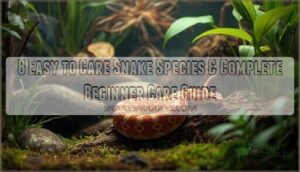This site is supported by our readers. We may earn a commission, at no cost to you, if you purchase through links.
 You’re not imagining things if you’ve seen a snake moving after death.
You’re not imagining things if you’ve seen a snake moving after death.
This eerie phenomenon happens because nerve cells in the spinal cord can stay active for hours, even after the brain stops working.
Think of it like a car engine that keeps running briefly after you turn off the ignition.
The snake’s reflexes fire automatically when you touch or disturb the body, making muscles contract and creating movement.
Cold-blooded animals like snakes experience this longer than warm-blooded creatures because their metabolism runs slower.
Even decapitated venomous snakes can still bite reflexively, which creates some surprising dangers you’ll want to know about, related to their ability to still bite.
Table Of Contents
- Key Takeaways
- How Long Do Snakes Move After Death?
- Snake Physiology After Death
- Factors Influencing Postmortem Snake Movement
- Safety Precautions and Awareness
- Implications and Awareness in Snake-Prone Areas
- Frequently Asked Questions (FAQs)
- Why do snakes move after death?
- What happens if a snake dies?
- What happens when you touch a dead snake?
- What happens if a snake dies after being beheaded?
- Do snakes bite after death?
- Can you pick up a dead snake?
- Do snakes move after they are killed?
- What is the reflex of a dead snake?
- How to tell if a snake has died?
- How long do snakes move after they are dead?
- Conclusion
Key Takeaways
- You’ll see snakes move for hours after death because their nerve cells stay active in the spinal cord, firing electrical impulses that trigger muscle contractions and reflexive movements.
- You can’t assume a dead snake is safe to handle since venomous species can still deliver fatal bites through reflexive jaw muscle contractions that persist long after death.
- You’re witnessing longer postmortem movement in snakes compared to warm-blooded animals because their cold-blooded metabolism runs slower and requires less oxygen to sustain nerve activity.
- You should always treat any deceased snake as dangerous and contact professionals for removal rather than attempting to handle it yourself, even if it appears completely lifeless.
How Long Do Snakes Move After Death?
When a snake dies, its body can still move for minutes to hours due to lingering nerve activity.
Even in death, a snake’s cold-blooded physiology keeps its nerves firing, causing hours of eerie postmortem movement.
These movements are purely reflexive and happen because the snake’s cold-blooded physiology allows its nerves to remain active longer than in warm-blooded animals, which can be attributed to its cold-blooded nature.
Postmortem Reflexes in Snakes
Even after death, snake reflexes can surprise you.
Postmortem reflexes result from residual nerve signals, causing muscle memory to trigger sudden movements or even bites.
This nerve activity can last hours, with venom delivery still possible.
Due to their cold-blooded nature, snakes exhibit prolonged postmortem activity.
Always handle snakes cautiously, as bite reflex persistence makes even a dead snake dangerous.
Ethical disposal guarantees safety and prevents accidental harm.
Nerve Function After Death
Surprisingly, nerve signals in dead snakes persist due to their cold-blooded physiology.
Their reptilian brain survives longer with minimal oxygen, sustaining nerve impulses. This postmortem nerve activity powers reflexes like biting.
Here’s how:
- Spinal cord activity keeps muscles twitching.
- Sensory organs remain partially responsive.
- Cellular electrical charge fuels random nerve signals, explaining why movements linger postmortem.
Some of these venoms contain snake venom proteases.
Duration of Reflexive Movements
Reflexive snake movements after death can last surprisingly long, thanks to lingering nerve activity and their cold-blooded physiology.
The table below breaks it down:
| Reflex Type | Movement Duration |
|---|---|
| Head movements | Several hours |
| Bite persistence | Up to an hour |
| Tail twitching | A few hours |
| Sensory responses | Hours post-death |
| Muscle spasms | Varies by species |
Snake postmortem movement varies by species and temperature effects, which is why it is crucial to handle them with caution due to their unpredictable cold-blooded physiology.
Snake Physiology After Death
Even after a snake dies, its body can still move due to lingering nerve activity in the spinal cord.
These reflexive actions aren’t controlled by the brain but result from the unique way a snake’s nervous system works.
Persistence of Spinal Cord Activity
A snake’s spinal reflexes remain active after death because its spinal cord and nerves still send residual electrical impulses.
This postmortem movement, driven by nerve activity, can cause involuntary muscle contractions.
Cold-blooded persistence lets these signals last longer than in warm-blooded creatures.
Post-mortem twitches are a result of these residual impulses.
Post-decapitation activity, like sudden movements or twitching, is fueled by spinal cord activity and lingering nerve signal duration, which can cause postmortem movement.
Reflexive Movements in Decapitated Snakes
When dealing with decapitated snakes, reflexive movements can be startling and dangerous.
These movements, fueled by lingering nerve activity, often include biting. Here’s why they happen:
- Decapitation Reflexes: Muscle memory triggers bites, even without a brain.
- Venomous Risks: Venom stays active, making postmortem bites potentially severe.
- Slow Metabolism: As ectotherms, their nerve activity persists longer after death.
Always handle with care to avoid accidents!
Sensory Organs Functionality
Even after death, a snake’s sensory organs, like the Jacobson’s Organ and infrared receptors, can still pick up signals for a while.
This lingering sensory perception happens because nerve activity doesn’t shut down immediately. In venomous species like pit vipers, this means their mouths and nerves can still respond to touch or vibrations, triggering reflexive bites.
Spinal cord activity also plays a role, as it keeps certain reflexes alive. These movements aren’t controlled by brain function but are powered by residual nerve function.
For example, vibration sensitivity in the mouth cavity can spark a bite reflex, potentially delivering venom even hours after death, due to the snake’s residual nerve function and vibration sensitivity.
Factors Influencing Postmortem Snake Movement
You might be surprised to learn that a snake’s cold-blooded metabolism plays a big role in its postmortem movements.
Combined with active nerve cells and lingering electrical signals, these factors keep the body twitching long after death.
Ectothermic Vertebrates’ Metabolism
Cold-blooded energy in ectothermic vertebrates like snakes relies on a slow metabolic rate.
After death, their physiology doesn’t shut down quickly, allowing snake reflexes after death to persist.
This extended activity stems from low oxygen consumption and minimal energy needs.
Postmortem reflexes include movements triggered by lingering activity levels in their nervous system, influenced by environmental impact and snake metabolism.
- Cold-blooded energy sustains longer reflexes
- Slow metabolic rate delays shutdown
- Minimal oxygen consumption supports nerve activity
- Environmental factors affect postmortem movements
Ions in Nerve Cells
You might think a snake’s story ends after death, but its nerve cells tell a different tale.
Thanks to ion channels and lingering action potentials, residual electrical impulses keep muscles twitching.
These movements happen because nerve cell ions like sodium and potassium maintain the resting potential.
- Reflexes can mimic life, startling handlers.
- Membrane permeability allows neurotransmitters to trigger surprising reactions.
Handle with care!
Comparison With Warm-Blooded Animals
Cold-blooded animals, like snakes, move longer after death due to metabolic differences.
Their body temperature and oxygen dependence are low, causing slow rigor mortis and prolonged reflex duration.
Warm-blooded animals lose nerve activity faster as their cells rely heavily on oxygen.
This nerve resilience in reptiles supports postmortem movement, including muscle contractions, making them seem alive even when they’re not.
This is partly due to their ability to use serpentine movement for locomotion.
Safety Precautions and Awareness
You can’t assume a snake is safe to handle just because it appears dead, since reflexive bites can still deliver venom for hours after death.
Even experienced handlers get caught off guard by this dangerous reality, so you’ll need to treat any deceased snake like it’s still capable of striking.
Risks of Handling Dead Snakes
Understanding why dead snakes move is one thing, but knowing the dangers they pose is another matter entirely.
Dead snakes aren’t harmless curiosities you can safely examine up close.
Their reflexive movements can trigger postmortem bites that inject venom just as effectively as living snakes.
Here’s what makes dead snake handling so risky:
- Venom potency remains unchanged for hours after death
- Reflexive jaw muscles can still deliver full-force bites
- Bacterial exposure from decomposing tissue adds infection risk
- Handling precautions often get ignored around "dead" animals
- Safe disposal requires tools, never bare hands
To mitigate these risks, consider using specialized protective equipment.
Even decapitated heads retain bite reflexes.
That seemingly lifeless snake can still ruin your day with a surprise strike.
Smart folks keep their distance and call professionals for removal instead, as it is the safest approach.
Implications of Cobra Bite Reflex
Cobras pack serious punch even after death.
Their cobra bite reflex stays active for hours, making postmortem reflexes incredibly dangerous.
You’re facing high venom potency and severe envenomation risks from what looks like a harmless dead snake.
The reflex duration can stretch several hours, so that "lifeless" cobra might deliver a bite severity that requires immediate medical treatment, due to the venom potency.
Seeking Medical Attention if Bitten
Despite the snake being dead, a snake bite demands immediate medical attention.
Rush to the hospital and identify the species for proper antivenom treatment.
Snake venom remains potent after death, causing severe bite symptoms like swelling, pain, and breathing difficulties.
Quick hospital treatment and antivenom access substantially improve recovery outcomes.
Don’t attempt first aid beyond basic wound care—professional treatment saves lives when dealing with snake bites.
Implications and Awareness in Snake-Prone Areas
If you live in areas where snakes are common, you need to understand that dead snakes can still bite and inject venom for hours after death.
This knowledge becomes critical when you’re hiking, camping, or working outdoors where you might encounter what appears to be a lifeless snake.
Venomous Snake Behavior After Death
Venomous snakes pose serious threats even after death through dangerous postmortem reflexes.
Cobra venom potency remains deadly for hours, while bite risks persist due to reflex venom delivery.
Envenomation symptoms can occur from handling precautions ignored around deceased specimens.
Snake reflexes trigger automatic strikes, making dead venomous snakes as hazardous as living ones through involuntary muscle contractions.
Globally, there are approximately 600 venomous snake species that pose a threat.
Risks and Cautions in Snake-Infested Environments
In snake-infested environments, you’re walking through a minefield of potential danger.
Snakebite Prevention starts with Habitat Awareness – knowing where venomous snakes lurk.
Even dead snake precautions matter since reflexes persist for hours.
Venomous Identification skills can save your life.
Always maintain snake safety precautions because snake bite risks don’t disappear when the snake stops moving.
Precautionary Measures for Dealing With Snakes
Understanding the risks isn’t enough—you need practical snake safety precautions to protect yourself.
Here’s your survival playbook:
- Safe Handling: Never touch any snake, dead or alive—their bite prevention starts with distance
- Species Identification: Learn local venomous snakes to assess venom potency risks quickly
- Disposal Methods: Use long tools, never bare hands, when removing dead snake precautions
- Emergency Response: Keep antivenom locations handy for snake bite risks
To guarantee safety, consider using specialized handling gear when dealing with snakes.
Frequently Asked Questions (FAQs)
Why do snakes move after death?
Death doesn’t immediately flip the off switch.
You’re witnessing residual nerve activity firing random electrical impulses through muscle tissue.
Cold-blooded physiology means cells survive longer without oxygen, creating these eerie postmortem movements.
What happens if a snake dies?
After death, a snake’s body can continue moving for hours due to nerve reflexes.
You’ll see muscle twitches and even biting motions.
Handle carefully—dead venomous snakes can still inject venom through reflexive strikes.
What happens when you touch a dead snake?
Touching a dead snake can trigger dangerous reflexes that last hours after death.
You’ll risk getting bitten since nerve signals still fire, muscles contract, and venom remains potent in deceased venomous species.
What happens if a snake dies after being beheaded?
A beheaded snake’s body continues moving for hours due to nerve signals still firing.
You’ll see muscle contractions, twitching, and reflexive movements as residual electrical impulses trigger responses throughout the disconnected nervous system, exhibiting residual behavior.
Do snakes bite after death?
Yes, you can still get bitten by a dead snake. Their reflexes remain active for hours after death, and venomous species can inject poison through these involuntary muscle contractions.
Can you pick up a dead snake?
Better safe than sorry—you shouldn’t pick up a dead snake.
Even deceased snakes can bite reflexively for hours after death, and venomous species still pose serious risks through lingering nerve activity.
Do snakes move after they are killed?
Snakes can move for hours after you kill them due to nerve activity that continues even after death.
Their cold-blooded nature allows reflexes to persist, making their bodies twitch and even bite reflexively.
What is the reflex of a dead snake?
Dead snakes retain powerful bite reflexes for hours after death.
You’ll see muscle twitching, striking motions, and jaw snapping due to lingering nerve signals.
Their venom glands stay active, making bites dangerous even postmortem.
How to tell if a snake has died?
Check for breathing by watching the snake’s sides for movement.
Look for a heartbeat near the head.
Touch the eye gently – living snakes will blink or react.
No response usually means death.
How long do snakes move after they are dead?
While you’d expect death to end all movement, snakes can continue moving for several hours afterward.
You’ll see twitching and reflexive movements due to residual nerve activity that persists long after the brain stops functioning, which can be attributed to reflexive movements.
Conclusion
Picture yourself walking away from what you thought was a lifeless snake, only to see it suddenly twitch behind you.
Now you understand why a snake moving after death isn’t supernatural—it’s science. These reflexive movements can last several hours due to active nerve cells in the spinal cord.
Remember to treat all dead snakes as potentially dangerous, especially venomous species that can still deliver fatal bites. Always maintain safe distance and contact professionals for removal.
- https://www.quora.com/Can-snakes-continue-to-live-for-about-another-hour-after-they-have-been-beheaded
- https://pmc.ncbi.nlm.nih.gov/articles/PMC9861841/
- https://archive.lstmed.ac.uk/21809/1/toxins-15-00049-v2.pdf
- https://www.nature.com/articles/s42003-024-06019-6.pdf
- https://www.workcare.com/app/uploads/2020/03/WorkCare-FactSheet-Snake-bite-treatment-and-prevention.pdf














